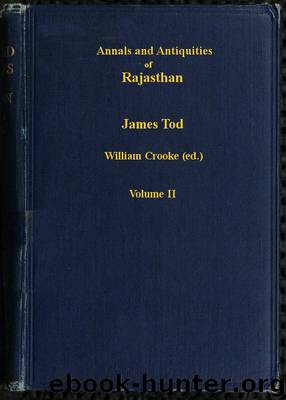Annals and Antiquities of Rajasthan, v. 2 of 3 or the Central and Western Rajput States of India by James Tod

Author:James Tod [Tod, James]
Language: eng
Format: epub
Published: 2018-07-04T16:00:00+00:00
Ahār.
—Ar, or Ahar,[17] near which we encamped, is sacred to the manes of the princes of Udaipur, and contains the cenotaphs of all her kings since the valley became their residence; but as they do not disdain association, either in life or death, with their vassals, Ar presents the appearance of a thickly crowded cemetery, in which the mausoleums of the Ranas stand pre-eminent in “the place of great faith.”[18] The renowned Amra Singh’s is the most conspicuous; but the cenotaphs of all the princes, down to the father of Rana Bhim, are very elegant, and exactly what such structures ought to be; namely, vaulted roofs, supported by handsome columns raised on lofty terraces, the architraves of enormous single blocks, all of white marble, from the quarries of Kankroli. There are some smaller tombs of a singularly elaborate character, and of an antiquity which decides the claims of Ar to be considered as the remains of a very ancient city. The ground is strewed with the wrecks of monuments and old temples, which have been used in erecting the sepulchres of the Ranas. The great city was the residence of their ancestors, and is said to have been founded by Asaditya upon the site of the still more ancient capital of Tambavatinagari, where dwelt the Tuar ancestors of Vikramaditya, before he obtained Avinti, or Ujjain. From Tambavatinagari its name was changed to Anandpur, ‘the happy city,’ and at length to Ahar, which gave the patronymic to the Guhilot race, namely, Aharya. The vestiges of immense mounds still remain to the eastward, called the Dhul-kot, or ‘fort,’ destroyed by ‘ashes’ (dhul) of a volcanic eruption. Whether the lakes of the valley owe their origin to the same cause which is said to have destroyed the ancient Ahar, a more skilful geologist must determine. The chief road from the city is cut through this mound; and as I had observed fragments of sculpture and pottery on the excavated sides, I commenced a regular opening of the mound in search of medals, and obtained a few with the effigies of an animal, which I fancied to be a lion, but others the gadha, or ass, attributed to Gandharvasen, the brother of Vikrama, who placed this impress on his coins, the reason of which is given in a long legend.[19] My impious intentions were soon checked by some designing knaves about the Rana, and I would not offend [794] superstition. But the most superficial observer will pronounce Ar to have been an ancient and extensive city, the walls which enclose this sepulchral abode being evidently built with the sculptured fragments of temples. Some shrines, chiefly Jain, are still standing, though in the last stage of dilapidation, and they have been erected from the ruins of shrines still older, as appears from the motley decorations, where statues and images are inserted with their heads reversed, and Mahavira and Mahadeva come into actual contact: all are in white marble. Two inscriptions were obtained; one very long
Download
This site does not store any files on its server. We only index and link to content provided by other sites. Please contact the content providers to delete copyright contents if any and email us, we'll remove relevant links or contents immediately.
| Africa | Americas |
| Arctic & Antarctica | Asia |
| Australia & Oceania | Europe |
| Middle East | Russia |
| United States | World |
| Ancient Civilizations | Military |
| Historical Study & Educational Resources |
The Sympathizer by Viet Thanh Nguyen(4096)
The Rape of Nanking by Iris Chang(4024)
World without end by Ken Follett(3347)
Ants Among Elephants by Sujatha Gidla(3282)
Blood and Sand by Alex Von Tunzelmann(3060)
Japanese Design by Patricia J. Graham(3004)
City of Djinns: a year in Delhi by William Dalrymple(2436)
Foreign Devils on the Silk Road: The Search for the Lost Treasures of Central Asia by Peter Hopkirk(2389)
Inglorious Empire by Shashi Tharoor(2347)
The Queen of Nothing by Holly Black(2324)
In Order to Live: A North Korean Girl's Journey to Freedom by Yeonmi Park(2304)
India's Ancient Past by R.S. Sharma(2303)
Tokyo by Rob Goss(2294)
India's biggest cover-up by Dhar Anuj(2249)
Tokyo Geek's Guide: Manga, Anime, Gaming, Cosplay, Toys, Idols & More - The Ultimate Guide to Japan's Otaku Culture by Simone Gianni(2243)
The Great Game: On Secret Service in High Asia by Peter Hopkirk(2231)
Goodbye Madame Butterfly(2163)
Batik by Rudolf Smend(2009)
Living Silence in Burma by Christina Fink(1985)
